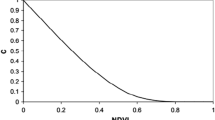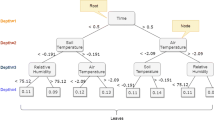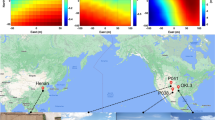Abstract
Path loss models are used to estimate the path loss between transmitter and receiver in applications that involve transmission of electromagnetic waves. This paper describes the wireless underground sensor networks, which communicates within the soil and is different from the terrestrial wireless sensor network. An integrated study of electromagnetic waves propagation for a wireless underground sensor network is described in this paper. Here, path loss model and signal strength are presented, because of electromagnetic waves attenuation in the soil medium. Tests were conducted at various soil volumetric water contents and node deployment depths using three different frequencies, when soil consists of 0% sands, 35% silt and 15% clay. The results showed that radio signal path loss was minimum when frequency and moisture content are low. The experimental results revealed that a 20% increase in the soil moisture content increased the path loss by more than 30%.







Similar content being viewed by others
References
Akyildiz IF, Stuntebeck EP (2006) Wireless underground sensor networks: research challenges. Ad Hoc Netw 4:669–686
Akyildiz IF, Su W, Sankarasubramaniam Y, Cayirci E (2002) Wireless sensor networks: a survey. Comput Netw 38(4):393–422
Akyildiz IF, Sun Z, Vuran MC (2009) Signal propagation techniques for wireless underground communication networks. Phys Commnu J 2(3):167–183
Bogena HR, Huismana JA, Meierb H, Rosenbauma U, Weuthena A (2009) Hybrid wireless underground sensor networks: quantification of signal attenuation in soil. Vadose Zone J 8(3):755–761
Daniels DJ (1996) Surface-penetrating radar. Electron Commun Eng J 8(4):165–182
Harun A, Ndzi DL, Ramli MF, Shakaff AYM, Ahmad MN, Kamarudin LM, Ndzi DL, Kamarudin LM, Muhammad EAA, Zakaria A, Ahmad RB, Malek MFBA, Shakaff AYM, Jafaar MN (2012) Vegetation attenuation measurements and modeling in plantations for wireless sensor network planning. Prog Electromagn Res B 36:283–301
Harun A, Ndzi DL, Ramli MF, Shakaff AYM, Ahmad MN, Kamarudin LM, Zakaria A, Yang Y (2012) Signal propagation in aquaculture environment for wireless sensor network applications. Prog Electromag Res 131:477–494
Hunt KP, Niemeier JJ, Kruger A (2010) RF communications in underwater wireless sensor networks. In: IEEE international conference on electro/information technology (EIT), pp 1–6
Li L (2008) Study on some key techniques in wireless underground sensor networks. Beijing University of Posts and Telecommunications, Beijing
Li L, Vuran MC, Akyildizy IF (2007) Characteristics of underground channel for wireless underground sensor networks. In: The sixth annual mediterranean ad hoc networking workshop, vol 6, pp 12–15
Miller TW, Borchers B, Hendrickx JMH, Hong SH, Dekker LW, Ritsema CJ (2002) Effects of soil physical properties on GPR for landmine detection. In: Proceedings of the fifth international symposium on technology and the mine problem
Ramo S, Whinnery J, Van DT (1994) Fields and water for communications electronics. Wiley, New York
Ritsema CJ, Kuipers H, Kleiboer L, Elsen E, Oostindie K, Wesseling JG, Wolthuis JW (2009) A new wireless underground network system for continuous monitoring of soil water contents. Water Resour Res 45(36):36–44
Sharma PK, Singh RK (2010) Comparative analysis of propagation path loss models with field measured data. Int J Eng Sci Technol 2(6):2008–2013
Silva AR, Vuran MC (2010) Integration of center pivot systems with wireless underground sensor networks for autonomous precision agriculture. In: IEEE international conference on cyber-physical systems, pp 79–88
Silva AR, Vuran MC (2010) Communication with above devices in wireless underground sensor networks: a empirical study. In: 2010 IEEE international conference on communications, pp 23–27
Stuber G (2001) Principles of mobile communication. Klumer, Dordrecht
Stuntebeck EP, Pompili D, Melodia T (2006) Wireless underground sensor networks using commodity terrestrial motes. IEEE, pp 112–114
Sun Z, Akyildiz IF (2008) Channel modeling of wireless networks in tunnels. In: Proceedings of IEEE Globecom 2008, New Orleans, USA
Tiusanen J (2005) Attenuation of a soil scout radio signal. Biosyst Eng 90(2):127–133
Tiusanen J (2007) Validation and results of the soil scout radio signal attenuation model. Biosyst Eng 97(1):11–17
Vuran MC, Akyildiz IF (2010) Channel model and analysis for wireless underground sensor networks in soil medium. Phys Commun 3(4):245–254
Wait J (1985) Electromagnetic wave theory. Harper and Row, New York
Wait J, Fuller J (1971) On radio propagation through earth: antennas and propagation. IEEE Trans Antennas Propag 19(6):796–798
Weldon TR, Rathore AY (1999) Wave propagation model and simulations for landmine detection. Technical report. University of N. Carolina at Charlotte
Acknowledgements
The authors wish to thank the National Engineering Research Center for Water-Saving Irrigation, which partially supported this research through the “National Natural Science Funds of China (51509207)”. The authors are also grateful to the anonymous reviewers for their valuable feedback.
Author information
Authors and Affiliations
Corresponding author
Rights and permissions
About this article
Cite this article
Yu, X., Han, W. & Zhang, Z. Path Loss Estimation for Wireless Underground Sensor Network in Agricultural Application. Agric Res 6, 97–102 (2017). https://doi.org/10.1007/s40003-016-0239-1
Received:
Accepted:
Published:
Issue Date:
DOI: https://doi.org/10.1007/s40003-016-0239-1




